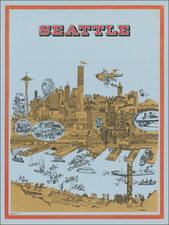Search
Irwin Caplan was an American illustrator, painter, designer and cartoonist, best known as the creator of The Saturday Evening Post cartoon series, Famous Last Words, which led to newspaper syndication of the feature in 1956.
Caplan grew up in Seattle's Madison Park neighborhood where his parents took note of his drawings and enrolled him in art classes. As a teenager, Caplan won $10 in a citywide poster contest, and at Garfield High School, he illustrated the 1935 yearbook, The Arrow. He painted murals of a circus and Paul Bunyan on walls of the school, where he graduated in 1937.
After graduating from the University of Washington, Caplan served during World War II as an Army illustrator, contributing to several military publications. Beginning in the Tank Force, he advanced to the Army Intelligence art department. When a Signal Corps editorial artist watched Caplan draw a cartoon and commented, "You know you can sell that stuff," Caplan put it in the mail and sold it to Collier's, launching his career as a cartoonist.
Returning to Seattle after the War, Caplan teamed with illustrator Ted Rand and five other artists to form Graphic Studios, creating corporate logos and a variety of advertising artwork. Caplan also illustrated the 1962 Seattle World’s Fair poster (sponsored by the Frederick & Nelson department store), plus work for the Seattle World’s Fair Alaska Pavilion. He was the art director for Spokane’s Expo ’74.
In the late 1940s through the early 1960s, Caplan's distinctive, crisp cartoon style appeared in Collier's, Esquire, Liberty, Life, Parade and other leading publications. For the Sunday supplement magazine This Week, he contributed a regular weekly thematic grouping of cartoons, sometimes in the form of a vertical comic strip. In addition to Famous Last Words, his other syndicated feature was 48 States of Mind.
Caplan's paintings were exhibited at New York's Metropolitan Museum of Art and the National Gallery in Washington, D.C., and his work was in the permanent collections of the Seattle Art Museum and the Henry Gallery.

